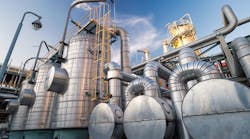Designing a distillation system to consistently achieve a given capacity at specified product purities involves more than sizing equipment and pipe. Feed changes, equipment constraints, uncontrolled disturbances, and periodic analyzer downtime can result in significant variations in product compositions (i.e., large standard deviation, σ). For this reason, it’s common to set target product purities significantly higher than specifications.
The choice of operating target typically is driven by factors such as:
- Performance record of similar units with a given operating target;
- The magnitude and frequency of anticipated disturbances (e.g., during furnace decoking on ethylene plants);
- Whether off-spec product is flared;
- The priority placed on quality and reputation as a supplier; and,
- Whether customer is willing to buy off-spec product.
If off-spec product must be flared, or an off-spec event requires a plant shut down, a large operating cushion (4σ or more) may be necessary. In many cases, supplying on-spec product outweighs all other requirements.
A track record of uninterrupted on-spec production enhances a supplier’s reputation, leading to a competitive advantage, including higher prices to customers. Conversely, selling off-spec product at reduced prices can be a bad idea. This tarnishes the supplier’s reputation and makes it difficult to sell on-spec product at full price. Customers may wait for an off-spec incident to buy at cut-rate prices.
Reduced variation (i.e., smaller σ) helps shift the composition operating target toward the product specification. This decreases heat loads and reflux requirements per unit feed, which improves energy efficiency. It also increases the capacity of the distillation system. Three important design improvements can reduce the variability of primary product composition:
Insulate overhead equipment and piping. This greatly decreases the impact of distillation’s most unforgiving disturbance, the summer rainstorm. Insulation isn’t a safety requirement on many distillation overhead systems, nor is it necessary for energy conservation in steady-state conditions. However, at the onset of a summer rainstorm, cool raindrops fall onto hot metal equipment and piping, causing a sudden increase in condensing duty and a rapid drop in pressure. Equilibrium liquids on trays vaporize, often leading to off-spec product and several hours of unsteady operation. Operators and the automation systems — even advanced process control systems — often are powerless to keep the system on-spec during and immediately following rainstorms in the absence of overhead insulation.
Increase holdup time for primary product. This is a guaranteed way to reduce product composition variation. A larger overhead accumulator or tower bottom serves as a product protector, dampening temporary upsets, regardless of cause, giving the operator time to make adjustments. Of course, a larger accumulator costs more than a smaller one, but the incremental cost is typically small compared to the cost of a single off-spec incident. Furthermore, a larger accumulator may eliminate the need to buy an off-spec tank.
The oversized accumulator (or bottoms) may be crucial if the distillate is the primary product and the feed is vapor phase. In this case, the tower overhead composition almost immediately reflects any change in feed composition. Similarly, if the bottom is the primary product and the feed is liquid, any change in feed composition goes directly to the bottom product.
Increase size of upstream vessel to dampen feed rate changes. Feed rate disturbances to a distillation system must be addressed. Unsteady feed leads to unsteady product. Increasing the liquid residence time of an upstream drum allows more time for the level controller to dampen feed rate changes. If a smaller drum is exposed to large feed rate changes, more-aggressive controller tuning is required to prevent overfill; this can lead to oscillations.
More opportunities for improving column control and saving energy, including enhanced regulatory process control strategies and the use of inferential process models, are discussed in C. Herzog, “Address Distillation Process Control During Design Phase to Save Energy and Increase Capacity,” AIChE Southwest Process Technology Conference, Sugar Land, Texas, October 1–2, 2019.
Charles Herzog is a Chemical Processing guest contributor. You can email him at [email protected].
Editor’s note: This article was written by a colleague of our regular columnist, Alan Rossiter. Charles Herzog is a process consultant with 40 years of experience in oil refining and petrochemicals, including all phases of plant design, startup and operations. He has detailed knowledge of ethylene technology and operations, and specializes in C2/C3 splitter operation and control, level control applications, test runs, process control training and refrigeration systems.


